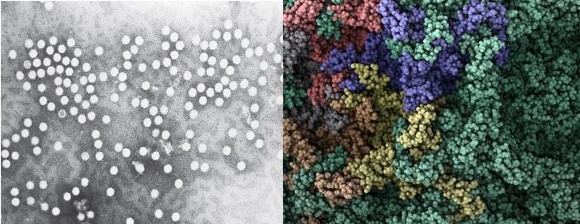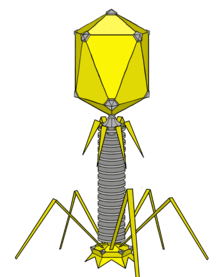Parvoviridae family has six (6) genera of virus which include Parvovirus, Contravirus, Erythrovirus, Dependovirus, Densovirus and Iteravirus. Parvovirus or the human parvovirus B19 is the major viral agent in this family of virus because it causes infections in humans. The family Parvoviridae also contains viruses that cause viral infection in animals. The human parvovirus B19 is small, non-enveloped virus with a linear, single-stranded DNA (ssDNA) genome. It is an erythrovirus in the Parvoviridae family.
Parvovirus measures between 18-26 nm in diameter; and they have a single-stranded DNA (ssDNA) genome. Their replication is within the nucleus of their host cell (specifically the erythroid precursor cells responsible for erythrocyte production in the bone marrow); and viruses in the Parvoviridae family are resistant to ether but sensitive to chlorine compounds, formalin and ultraviolet (UV) light.
Viruses in the Parvoviridae family lack envelope (i.e. they are naked viruses), and they have an icosahedral shape or structure. They are relatively stable at high temperature; and viruses in this family are released through the lysis of infected host cell(s) since they lack envelope. Human parvovirus B19 causes erythema infectiosum in children and aplastic crises in sickle cell and anaemic patients.
Erythema infectiosum is also called the “fifth disease”; and it is usually characterized clinically as the onset of an erythematous rash (known as slapped cheek syndrome) on the face of the infected child. It is called “slapped cheek syndrome” because the both cheeks of infected children appear as though they have been slapped on both sides. There is rapid destruction of the red blood cells (RBCs) of anaemic or sickle cell individuals infected with the virus due to its replication in the blood cells or bone marrow of these persons.
Parvovirus B19 viral infection has also been associated with spontaneous abortion in humans (Table 1). The incubation period of human parvovirus B19 infection is usually between 12-18 days; and the disease onset is usually characterized by the appearance of a maculopapular rash on the body of infected children. Upper respiratory symptoms, fever and malaise are other associated signs of the disease. Its transmission route is via infected blood and the respiratory route. Parvovirus infects mostly children, and the disease has a worldwide prevalence.
However, immunocompromised individuals, pregnant women and people with haemolytic anaemia are also at risk of contamination. No specific prophylaxis or vaccine exists for human parvovirus infection; and there’s also no specific antiviral treatment for the disease.
Table 1. DNA viruses that parasitize humans
| Viral family | Representative viruses | Replication site | Genome |
| Poxviridae | Cowpox, smallpox, monkey pox viruses and other poxviruses | Outside the nucleus | dsDNA (plus envelope) |
| Herpesviridae | Herpes simplex viruses (HSV) types 1 and 2, Epstein-Barr virus (EBV), cytomegalovirus (CMV), Varicella-zoster virus (VZV), Kaposi’s sarcoma-associated herpes virus (KSHV) and human herpes viruses 6 and 7 | Nucleus | dsDNA (plus envelope) |
| Adenoviridae | Adenoviruses | Nucleus | dsDNA (no envelope) |
| Papillomaviridae | Papilloma viruses | Nucleus | dsDNA (no envelope) |
| Polyomaviridae | Polyomaviruses | Nucleus | dsDNA (no envelope) |
| Parvoviridae | Human parvovirus B19, Dependovirus, Erythrovirus, Iteravirus, and contravirus | Nucleus | ssDNA (no envelope) |
| Hepadnaviridae | Hepatitis B virus (HBV) | Nucleus | ssDNA (no envelope) |
| dsDNA=double stranded DNA; ssDNA=single stranded DNA | |||
References
Acheson N.H (2011). Fundamentals of Molecular Virology. Second edition. John Wiley and Sons Limited, West Sussex, United Kingdom.
Alan J. Cann (2005). Principles of Molecular Virology. 4th edition. Elsevier Academic Press, Burlington, MA, USA.
Alberts B, Bray D, Johnson A, Lewis J, Raff M, Roberts K and Walter P (1998). Essential Cell Biology: An Introduction to the Molecular Biology of the Cell. Third edition. Garland Publishing Inc., New York.
Barrett J.T (1998). Microbiology and Immunology Concepts. Philadelphia, PA: Lippincott-Raven Publishers. USA.
Black, J.G. (2008). Microbiology: Principles and Explorations (7th ed.). Hoboken, NJ: J. Wiley & Sons.
Brian W.J Mahy and Mark H.C van Regenmortel (2010). Desk Encyclopedia of Human and Medical Virology. Elsevier Academic Press, San Diego, USA.
Brooks G.F., Butel J.S and Morse S.A (2004). Medical Microbiology, 23rd edition. McGraw Hill Publishers. USA.
Cann A.J (2011). Principles of Molecular Virology. Fifth edition. Academic Press, San Diego, United States.
Carter J and Saunders V (2013). Virology: Principles and Applications. Second edition. Wiley-Blackwell, New Jersey, United States.
Champoux J.J, Neidhardt F.C, Drew W.L and Plorde J.J (2004). Sherris Medical Microbiology: An Introduction to Infectious Diseases. 4th edition. McGraw Hill Companies Inc, USA.
Dimmock N (2015). Introduction to Modern Virology. Seventh edition. Wiley-Blackwell, New Jersey, United States.
Dimmock N.J, Easton A.J and Leppard K.N (2001). Introduction to modern virology. 5th edition. Blackwell Science publishers. Oxford, UK.
Discover more from #1 Microbiology Resource Hub
Subscribe to get the latest posts to your email.



